Updated on 03/13/2024
Dear reader,
I would also like to recommend our Colombia travel guide, which provides a perfect overview of the tourist attractions in Colombia. Enjoy reading it!
Content
Introduction to the Heritage Towns of Colombia
Embarking on a journey to Colombia unveils a myriad of possibilities, encompassing vibrant cities, diverse natural wonders, and a tapestry of colonial towns. Notably, 17 towns have earned the distinction of being declared the nation’s Cultural Heritage. Within these destinations, the indelible imprint of the Spanish Empire on Colombia’s culture and architecture becomes evident.
During the era when Colombia was known as Nueva Granada, a Spanish colony, these towns were founded, some tracing back to the 16th century. Preserving the colonial legacy, these locales feature cobbled paths, white houses adorned with clay-tiled roofs, and grand structures reminiscent of ancient temples. Exploring these historic towns reveals centuries-old churches, impeccably preserved houses, and picturesque elements like bridges, encapsulating the enduring charm of Colombia’s colonial past.
Villa de Leyva
- Location: Boyacá Department, Colombia
- Population: Approximately 16,000 residents
- Weather and Climate: Villa de Leyva enjoys a temperate climate with average temperatures around 17°C (63°F). The dry season typically spans from December to February.
- Elevation: 2,144 meters (7,037 feet) above sea level
- Foundation Date: Originally founded in 1512, officially relocated to its current site on the 12th of June, 1572.
Local Culture
Villa de Leyva stands as the most renowned historical city in Colombia, celebrated for its rich culture, traditions, and colonial architecture. Designated a national monument in 1954, the city offers a captivating journey into the past, drawing visitors with its historical allure.
History
Villa de Leyva’s history unfolds through significant milestones:
- Early Beginnings (1512): Villa de Leyva was originally founded in 1512. This early establishment marked the beginning of its historical journey, initially as a small settlement during the Spanish colonial era.
- Official Relocation (1572): The town was officially relocated to its current site on June 12, 1572. This move was significant in shaping the town’s layout and architecture, leading to the development of its unique colonial character.
- Santo Ecce Homo Monastery (1620): The establishment of the Santo Ecce Homo Monastery by the Dominican Order in 1620 was a key event in Villa de Leyva’s history. This monastery became an important religious and cultural center in the region, contributing to the town’s religious and architectural heritage.
- El Cárcamo (1599): The inauguration of El Cárcamo in 1599 marked the establishment of one of the most important farms in the municipality. It also served as the home of Juan José Neira, a hero of Colombia’s independence. This site played a significant role in the town’s economic and social history.
- National Monument Designation (1954): Villa de Leyva was designated as a national monument in 1954. This recognition was pivotal in preserving the town’s colonial architecture and historical significance, highlighting its importance as a cultural and historical site in Colombia.
- Present Day: Today, Villa de Leyva remains a well-preserved example of a colonial town in Colombia. Its cobblestone streets, whitewashed buildings, and historical landmarks continue to attract visitors from around the world, making it a key destination for cultural and historical tourism.

The history of Villa de Leyva, from its original foundation to its current status as a national monument, encapsulates a rich tapestry of cultural and historical significance, illustrating the town’s evolution over centuries and its enduring legacy in Colombian heritage.
Economy
Villa de Leyva’s economy thrives on tourism, agriculture, and craftsmanship. The town’s historic charm and cultural richness attract visitors, contributing significantly to the local economy. Craftsmanship includes the production of traditional items such as pottery and textiles.
Tourism
Villa de Leyva, with its well-preserved colonial architecture and rich cultural heritage, has become a popular tourist destination. The town sees a significant influx of visitors, both domestic and international, seeking to immerse themselves in its historical ambiance. While specific tourism numbers may vary, the town experiences peaks during festivals and special events.
Tourist Attractions and Activities in Villa de Leyva:
Tourist Attractions and Activities in Villa de Leyva:
- Churches: Marvel at the Parish Church of Our Lady of the Rosary, Church of the Virgin of Carmen, Convent of the Discalced Carmelites, Monastery of the Carmelites, and the Cloister of St. Augustine.
- Monquirá Archaeological Park: Explore “El Infiernito,” a site significant for its pre-Colombian culture and astronomical importance.
- Cave Paintings: Discover the Chibchas’ cave paintings, located approximately 7 kilometers from Villa de Leyva.
- Paleontological Museum: View a vast collection of fossils, including a striking 110-million-year-old specimen over 7 meters long.
- Ostrich Farm: Learn about and interact with ostriches in a farm setting.
- Ain Karim Vineyard: Experience the local wine production process, complete with tastings and regional delicacies.
- Santo Ecce Homo Monastery: Appreciate the colonial architecture and serene gardens of this historical site.
- El Cárcamo: Visit the historic building, once the residence of independence hero Juan José Neira, inaugurated in 1599.
- Theme Park 1900: Step back in time with exhibitions featuring various 20th-century automobiles.
- Iguaque Flora and Fauna Sanctuary: Hike through unique paramos and lagoons, considered sacred by the Muiscas.
- Pozos Azules: Witness the beauty of 6 small artificial lakes located about 1.8 miles from Villa de Leyva.
- Villa de Leyva’s Desert: Experience the desert landscape through activities like motocross or mountain biking and discover fossils.
- Fossil Museum: A museum dedicated to showcasing a variety of ancient fossils found in the region, including the remains of marine creatures and dinosaurs.
- Casa Terracota: Visit this unique house entirely made of clay, known as the largest piece of pottery in the world.
- Plaza Mayor: Spend time in one of the largest town squares in the Americas, surrounded by colonial buildings and vibrant local life.
- Antonio Ricaurte Museum: Explore the house and history of Antonio Ricaurte, a hero of the Colombian independence movement.
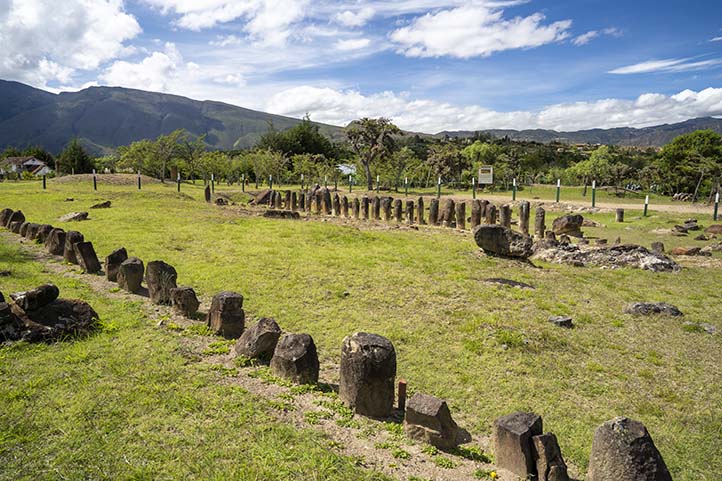
Local Food
The culinary scene in Villa de Leyva showcases traditional Colombian flavors. Visitors can savor local specialties such as arepas, empanadas, and a variety of dishes featuring regional ingredients. Street vendors and local eateries offer an authentic taste of the region’s gastronomy.
Special Information
While exploring Villa de Leyva, it’s advisable to embrace the town’s unhurried pace. The charm lies in strolling through cobblestone streets, admiring colonial architecture, and engaging with the friendly locals. The town’s festivals, including the Festival of Lights and the Kite Festival, bring vibrant energy but may also attract larger crowds. Travelers seeking a more tranquil experience may prefer visiting during non-festival periods. Additionally, the town’s elevation requires visitors to acclimate, ensuring a comfortable and enjoyable stay.
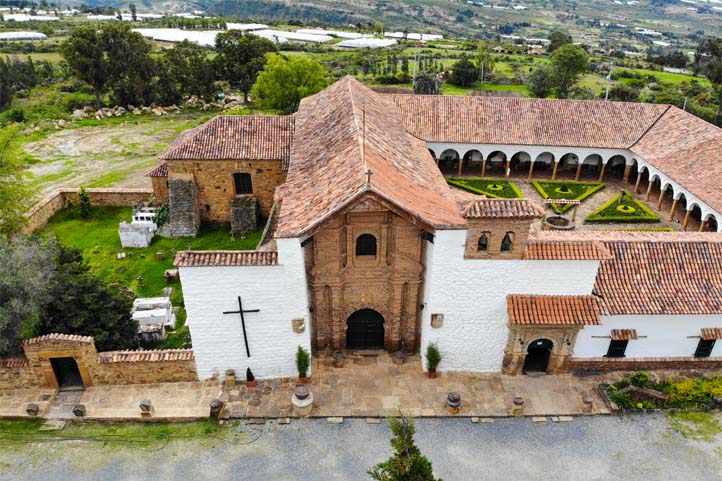
How to get to Villa de Leyva
Villa de Leyva is approximately 165 kilometers (103 miles) from Bogota, requiring 3-4 hours of travel, dependent on traffic conditions in Bogota. The town is accessible by car or bus, and its remote location contributes to its preserved historic atmosphere.
If you are looking for a nice hotel, check out our recommendations with some very nice hotels in Villa de Leyva.
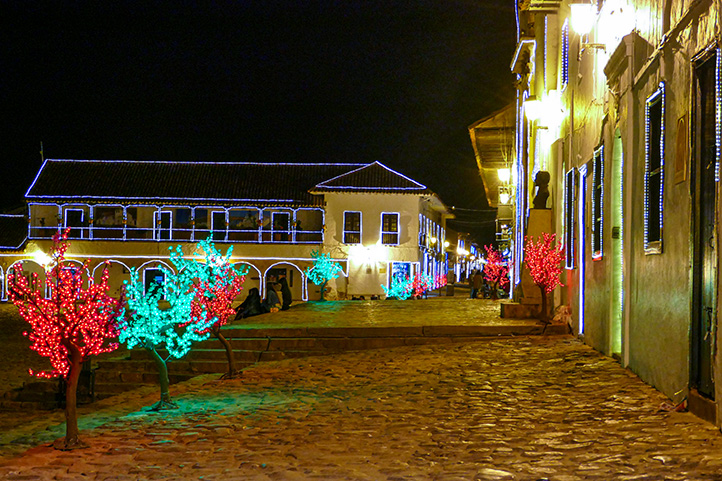
Monguí
- Location: Boyacá Department, Colombia
- Population: Approximately 4,000 people
- Weather and Climate: Monguí experiences cool temperatures, prompting the need for warm clothing. The production of traditional ruanas (poncho-like cloaks) locally adds to the cultural experience.
- Elevation: Approximately 2,800 meters (9,200 feet)
- Foundation Date: 1601
Local Culture
Monguí, recognized for its colonial architecture and soccer ball production, holds the distinction of being declared a national monument in 1975. The city’s cobblestone walkways and colorful buildings contribute to its charm, creating an atmosphere that transports visitors back in time.
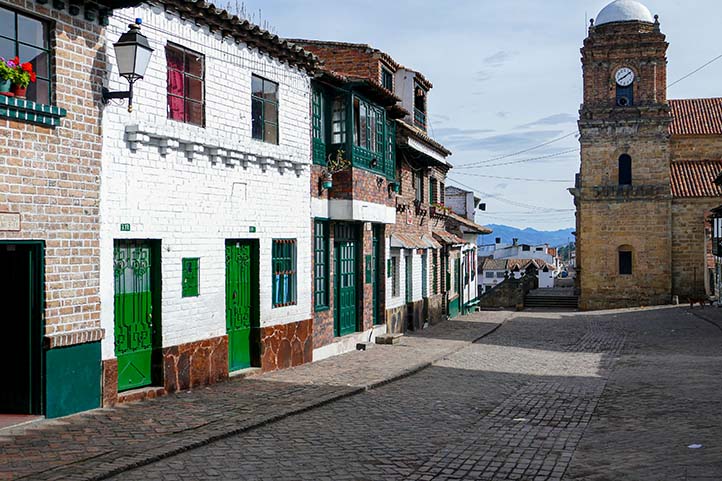
History of Monguí
Monguí’s historical timeline is marked by significant events that have shaped its identity:
- Founding (1601): Monguí’s establishment in 1601 firmly positions it within the fabric of Colombia’s colonial history. This founding period significantly influenced the town’s culture and architecture, setting the foundation for its future development and historical significance.
- Colonial Development (17th – 18th Centuries): Throughout the 17th and 18th centuries, Monguí developed under Spanish colonial rule. The town’s architecture, urban layout, and cultural practices were heavily influenced by this era, leading to the creation of a distinct colonial identity.
- Post-Independence Era (19th Century): Following Colombia’s independence from Spain in the 19th century, Monguí, like many Colombian towns, underwent a period of transformation. The town adapted to the changes brought about by the new republic, while preserving its colonial heritage.
- National Monument Designation (1975): Recognizing Monguí’s rich historical and architectural heritage, the town was designated a national monument in 1975. This designation underscored the town’s role in preserving Colombian history and its importance in maintaining architectural styles from the colonial era.
- Modern Times (Late 20th – 21st Century): In recent decades, Monguí has focused on balancing the preservation of its historical legacy with modern development. The town has become a destination for those interested in Colombia’s colonial past, offering a glimpse into the country’s rich historical tapestry through its well-preserved architecture and cultural traditions.
- Present Day: Today, Monguí continues to be celebrated for its cultural and historical significance. The town attracts visitors and historians eager to explore its colonial legacy, standing as a testament to the enduring impact of Colombia’s colonial era on its contemporary identity.
The history of Monguí, from its foundation in the early 17th century to its recognition as a national monument, illustrates its vital role in preserving Colombia’s colonial history and architectural heritage.
Economy
Monguí’s economy revolves around soccer ball production, contributing to its recognition in this industry. The city’s unique economic activities include the local production of ruanas, offering visitors distinct garments with cultural value.
Tourism
Monguí, celebrated as one of the most beautiful cities in Boyacá, beckons tourists with its colonial monuments and natural landscapes. The city’s attractions include:
Tourist Attractions and Activities in Monguí:
- Minor Basilica of Our Lady of Monguí: A national monument since 1975, this basilica boasts beautiful Romanesque design and historical significance. Visitors can explore its architectural marvel and delve into its rich history.
- Franciscan Convent Museum: Situated in the same location as the basilica, the museum showcases objects from the 18th century, providing insights into the Franciscan order’s history.
- Colonial Bridge Real Calicanto: An 18th-century bridge built by the indigenous Sanoha tribe, this landmark offers a glimpse into the city’s historical transportation infrastructure.
- Football Museum: Shedding light on Monguí’s specialty in football production, the museum allows visitors to understand the manufacturing process and participate in workshops.
Natural Landscapes:
- Ocetá Paramo: Considered the most beautiful paramo globally, this natural landscape offers a three-hour walk through diverse flora, fauna, waterfalls, springs, and other natural wonders. Photographers will find ample opportunities to capture the unique beauty of Ocetá.
- Peña de Otí: Located just 10 minutes from Monguí, Peña de Otí combines nature and history, serving as the extraction site for stones used in the basilica’s construction. The area is associated with local folklore, featuring the court of the witches. An excursion to Peña de Otí culminates in a lookout point with panoramic views, providing a scenic overview of the surrounding landscape.
Local Food
Monguí is known for its traditional Colombian cuisine, offering visitors a taste of local flavors. Typical dishes may include arepas, empanadas, and regional specialties.
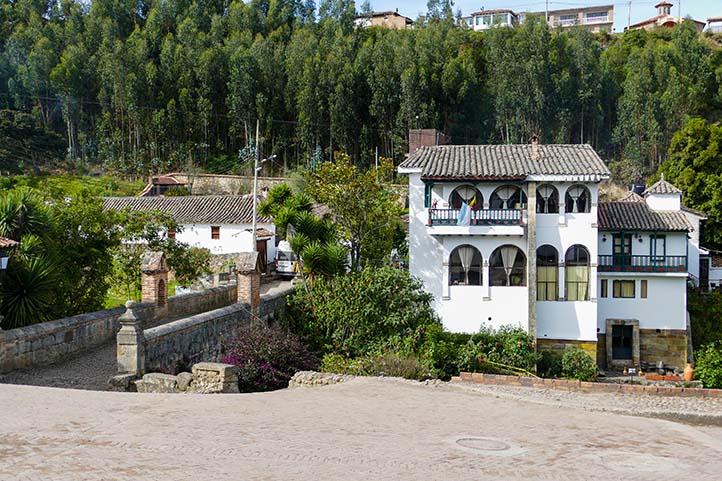
Special Information
Visitors to Monguí should embrace the town’s cultural and historical ambiance. The availability of traditional ruanas provides an opportunity to experience local attire. The city’s elevation and cool temperatures necessitate warm clothing, enhancing the experience of exploring its charming streets and landmarks.
How to get to Monguí
Traveling from Bogotá to Monguí covers approximately 223 km (139 miles) and takes approximately 3 hours and 30 minutes, depending on traffic conditions. The journey offers a scenic route to this culturally rich and picturesque destination in Boyacá.
Barichara
- Location: Santander Department, Colombia
- Population: Approximately 7,000 residents
- Weather and Climate: Barichara enjoys a mild climate with average temperatures around 22°C (72°F). The dry season typically spans from December to February.
- Elevation: 1,350 meters (4,429 feet) above sea level
- Foundation Date: Founded on January 4, 1705, by the Spanish Captain Juan de Guzmán.
Local Culture
Barichara is a cultural gem in Colombia, renowned for its preserved Spanish colonial architecture and cobblestone streets. Designated a National Monument in 1978, the town offers an authentic glimpse into Colombia’s historical and cultural heritage.
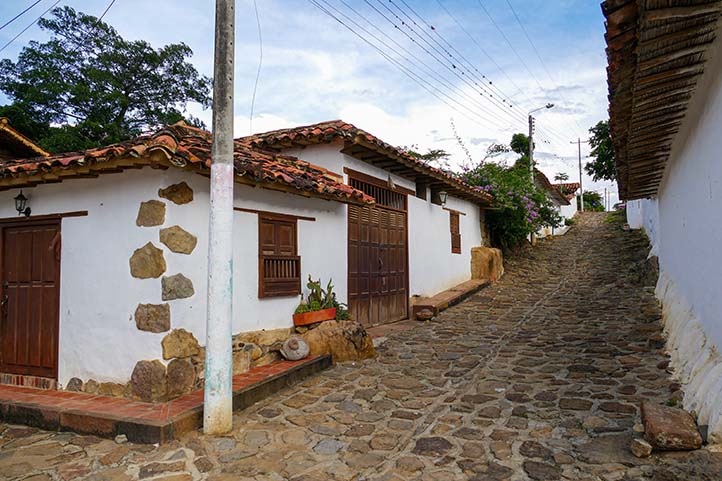
History of Barichara
Barichara’s rich history is marked by several significant milestones that highlight its cultural and architectural heritage:
- 1705: The founding of Barichara dates back to January 4, 1705, by Spanish Captain Juan de Guzmán. This period marked the beginning of its colonial legacy, shaping the town’s architectural and cultural landscape.
- Throughout the 18th and 19th Centuries: Barichara grew and developed, with its architecture and urban layout largely influenced by Spanish colonial styles. The town’s stone streets, whitewashed buildings, and unique construction techniques became defining features.
- 1847: A notable event in Barichara’s history is the reconstruction of the Santa Bárbara church, which became an iconic symbol of the town’s architectural heritage.
- Late 19th Century: During this time, Barichara witnessed a period of economic growth and cultural development. The town’s strategic location contributed to its role in regional trade and commerce.
- 1975: Barichara was declared the “prettiest village in Colombia” by Colombian President Alfonso López Michelsen, which significantly boosted its national recognition and pride.
- 1978: The town was officially designated as a National Monument, a testament to its well-preserved colonial architecture. This recognition brought attention to the need for preservation and conservation of its historical buildings and streets.
- Early 21st Century: Barichara began to gain recognition as a tourist destination, renowned for its historical significance, architectural beauty, and tranquil atmosphere.
- Recent Years: The town has continued to preserve its historical and cultural identity while adapting to modern times. It has become a center for cultural events, arts, and crafts, attracting visitors from around the world.
These milestones in Barichara’s history have not only preserved its colonial charm but also transformed it into a living museum, showcasing the rich heritage of Colombia’s colonial past.
Economy
Barichara’s economy relies on tourism, agriculture, and local craftsmanship. The town’s colonial charm and cultural heritage attract visitors, contributing to its economic vitality. Craftsmanship includes the production of handcrafted goods like textiles and woodwork.
Tourism
Barichara has become a sought-after tourist destination, offering visitors a step back in time with its well-maintained colonial ambiance.
Tourist Attractions and Activities in Barichara:
- Cathedral of the Immaculate Conception: Explore this iconic cathedral with its impressive architecture.
- Camino Real: Walk the historic cobblestone path leading to the neighboring town of Guane.
- Plaza Principal: Enjoy the main square, surrounded by colonial buildings and featuring a statue of Simón Bolívar.
- Santa Bárbara Chapel: Visit this charming chapel known for its simple yet captivating design.
- Guane: Take a short hike or drive to the nearby town of Guane, known for its archaeological museum.
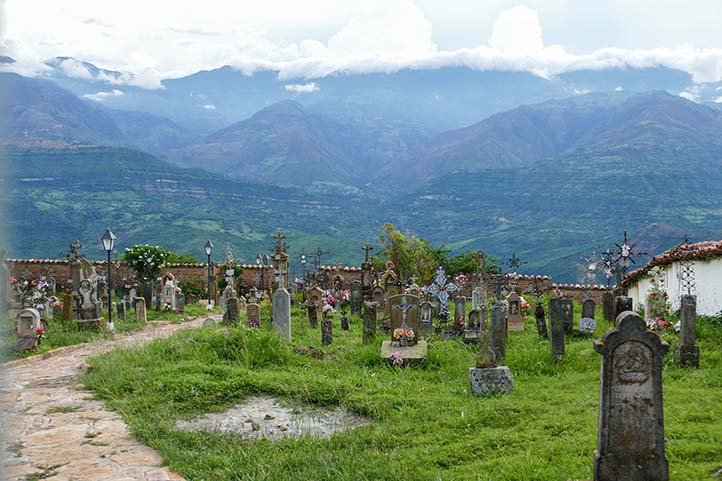
Local Food
Barichara’s culinary scene reflects the region’s traditional flavors. Visitors can indulge in local dishes such as “mazamorra,” a traditional corn-based soup, and “cabro,” a goat meat specialty.
Special Information
Barichara invites visitors to immerse themselves in its tranquil atmosphere. Strolling through the well-preserved streets and engaging with locals provides a genuine experience. The town hosts cultural events and festivals, adding vibrancy to its historical charm.
How to get to Barichara
Barichara is approximately 120 kilometers (75 miles) from Bucaramanga, requiring around 3-4 hours of travel by car. The journey offers picturesque views of the Santander countryside. Visitors can also take a bus to Barichara from Bucaramanga or San Gil, adding an adventurous touch to their arrival.
El Socorro
- Location: Santander Department, Colombia
- Population: Approximately 17,000 residents
- Weather and Climate: El Socorro enjoys a tropical climate with average temperatures around 26°C (79°F). The rainy season typically occurs from April to November.
- Elevation: 610 meters (2,000 feet) above sea level
- Foundation Date: Founded on January 10, 1681, by Francisco Díaz de Arce.
History
El Socorro’s history, rich with significant events, showcases its evolution over the centuries:
- 1681: The foundation of El Socorro is traced back to January 10, 1681, by Captain Francisco Díaz de Arce. This marked the beginning of its establishment as an important colonial town in the region.
- 1700s: Throughout the 18th century, El Socorro played a significant role in regional agricultural development, particularly in the cultivation of tobacco, which became a cornerstone of its economy.
- 1781: The town became a pivotal center during the Comunero Revolt against Spanish colonial rule. The revolt, one of the first major uprisings in Colombian history, was significantly influenced by El Socorro’s residents.
- 19th Century: Following Colombia’s independence, El Socorro continued to develop, maintaining its status as an important agricultural and commercial center. Its architecture and urban planning began to reflect the newfound national identity.
- 1959: Recognizing its rich historical and architectural heritage, El Socorro was designated a National Monument. This designation aimed to preserve its colonial architecture and historical significance.
- 1960s-1970s: During this period, El Socorro experienced modernization while preserving its historical landmarks. Efforts were made to maintain the town’s colonial charm amid growing urban development.
- 2000s: The town became increasingly recognized for its historical importance and began attracting tourists interested in Colombia’s colonial history and architecture.
- Recent Years: El Socorro has continued to balance preservation with modernity, becoming a hub for cultural events and historical tourism in Colombia. Its role in Colombian history, particularly in the fight for independence, remains a point of pride for its residents.
These key dates and events in El Socorro’s history illustrate the town’s evolution from a colonial settlement to a national monument, highlighting its significant role in Colombia’s historical and cultural narrative.
Economy
El Socorro’s economy is diversified, encompassing agriculture, commerce, and crafts. The town’s historical significance contributes to its appeal, attracting both local and international visitors.
Tourism
El Socorro is emerging as a cultural and historical destination, offering a glimpse into Colombia’s colonial past.
Tourist Attractions and Activities in El Socorro:
- Cathedral Basilica of Our Lady of the Immaculate Conception: Explore the grandeur of this historic cathedral.
- Plaza de Mercado: Visit the local market to experience the vibrant atmosphere and discover regional products.
- La Casa de la Cultura: Immerse yourself in local arts and cultural events.
- Museum of Religious Art: Admire a collection of religious artifacts and artworks.
Local Food
El Socorro’s culinary scene reflects its diverse cultural influences. Local eateries offer a variety of traditional Colombian dishes, including “mamona” (roast beef) and “cabro” (goat meat).
Special Information
Exploring El Socorro provides a unique opportunity to witness a harmonious blend of colonial architecture and indigenous traditions. The town’s festivals, such as the Holy Week celebrations, showcase its cultural richness.
How to get to El Socorro
El Socorro is approximately 153 kilometers (95 miles) from Bucaramanga, accessible by car or bus. The journey takes around 3-4 hours, offering scenic views of the Colombian countryside. Visitors can also explore nearby towns, such as San Gil, to enhance their cultural experience.
San Juan de Girón
- Location: Santander Department, Colombia
- Population: Approximately 30,000 residents
- Weather and Climate: San Juan de Girón enjoys a temperate climate with average temperatures around 21°C (70°F). The dry season typically spans from December to February.
- Elevation: 980 meters (3,215 feet) above sea level
- Foundation Date: Founded on January 26, 1631, by Francisco Mantilla de los Ríos.
Local Culture
San Juan de Girón, a picturesque colonial town, stands as a living testament to Colombia’s cultural heritage. Designated a National Monument in 1959, it preserves its historical charm through well-preserved architecture and traditions.
History
San Juan de Girón, often simply known as Girón, boasts a rich history characterized by several important milestones:
- 1631: The town was founded on January 26, 1631, by Francisco Mantilla de los Ríos. This period marked the town’s inception under Spanish colonial rule and laid the foundation for its future development.
- 17th and 18th Centuries: Throughout these centuries, Girón evolved significantly under Spanish colonial influence. The town developed its unique architectural style, characterized by colonial houses with balconies, cobbled streets, and whitewashed walls.
- 19th Century: During this time, Girón witnessed significant changes as Colombia gained independence from Spain. The town’s development during this period was marked by the transition from colonial rule to the establishment of a republic.
- 1959: In recognition of its well-preserved colonial architecture and historical importance, San Juan de Girón was designated as a National Monument. This honor underscored the need to preserve its unique colonial heritage.
- 20th Century: Throughout the 20th century, Girón continued to maintain its colonial charm while adapting to modernity. The town became a center for cultural and historical tourism in Colombia.
- Late 20th and Early 21st Century: Girón started gaining more recognition as a tourist destination, attracting visitors with its historical architecture, serene plazas, and traditional festivals.
- Recent Developments: In recent years, Girón has focused on preserving its historical and cultural heritage while promoting sustainable tourism. The town has been involved in various preservation projects to maintain its colonial buildings and public spaces.
These key events in the history of San Juan de Girón highlight its transformation from a colonial settlement to a town celebrated for its architectural and historical significance, playing an important role in Colombia’s cultural landscape.
Economy
The economy of San Juan de Girón thrives on tourism, commerce, and agriculture. The town’s colonial architecture and cultural events attract visitors, contributing to its economic vitality.
Tourism
San Juan de Girón has become a sought-after destination for those seeking a glimpse into Colombia’s colonial past.
Tourist Attractions and Activities in San Juan de Girón:
- Plaza Principal: Explore the main square surrounded by colonial buildings and the Parish Church of St. John the Baptist.
- Calle de las Cruces: Wander through this iconic street adorned with crosses, representing the town’s cultural and religious heritage.
- Capilla de las Nieves: Visit this chapel known for its simple yet captivating design.
- Museum of Religious Art: Admire a collection of religious artifacts and artworks.
- Puente de los Comuneros: Cross the bridge with historical significance, connecting Girón to Bucaramanga.
Local Food
San Juan de Girón’s culinary scene embraces traditional Colombian flavors. Visitors can savor local specialties such as “mazamorra” and “cabro,” reflecting the region’s culinary heritage.
Special Information
Exploring San Juan de Girón offers a journey through cobblestone streets lined with colonial facades. The town hosts cultural events, including the Holy Week celebrations, adding vibrancy to its historical ambiance.
How to get to San Juan de Girón
San Juan de Girón is approximately 8 kilometers (5 miles) from Bucaramanga, accessible by car or public transportation. The short journey provides an opportunity to experience the transition from the bustling city to the tranquility of the colonial town.
San Miguel de Guaduas
- Location: Cundinamarca Department, Colombia
- Population: Approximately 20,000 residents
- Weather and Climate: San Miguel de Guaduas experiences a tropical climate with average temperatures around 24°C (75°F). The town has a relatively consistent climate throughout the year.
- Elevation: 1,406 meters (4,613 feet) above sea level
- Foundation Date: Founded on March 20, 1852, by Francisco Javier de Umaña.
Local Culture
San Miguel de Guaduas boasts a rich cultural heritage, blending indigenous influences with colonial history. The town holds cultural events and traditions that reflect its diverse history.
History
San Miguel de Guaduas, often referred to simply as Guaduas, has a history marked by several key events and developments:
- 1852: The founding of San Miguel de Guaduas dates back to March 20, 1852, by Francisco Javier de Umaña. This marked the establishment of the town in the mid-19th century, during a period of significant national change and development in Colombia.
- Late 19th Century: After its foundation, Guaduas began to develop as an agricultural center. The town’s economy was primarily based on the cultivation of coffee, sugarcane, and other crops, which played a crucial role in its growth and development.
- Early 20th Century: During this period, Guaduas experienced further growth and modernization. The town started to build infrastructure like roads and public buildings, reflecting a period of economic and social development.
- Mid-20th Century: Guaduas began to gain recognition for its cultural and historical significance, particularly for its colonial architecture and role in regional history.
- Late 20th Century: The town focused on preserving its historical heritage, including colonial-style buildings and traditional customs. Efforts were made to maintain the cultural identity of Guaduas while adapting to modernity.
- 21st Century: In recent years, Guaduas has become known as a cultural and historical destination. The town attracts tourists interested in its colonial architecture, historical significance, and scenic beauty.
- Recent Developments: Today, San Miguel de Guaduas continues to balance its historical preservation with modern needs. It is involved in various cultural and environmental preservation projects and remains a vital part of Colombia’s rich historical tapestry.
Throughout its history, San Miguel de Guaduas has evolved from a small mid-19th-century town to a modern municipality that values and preserves its historical and cultural heritage.
Economy
The economy of San Miguel de Guaduas is based on agriculture, commerce, and local crafts. The town’s historical significance and natural surroundings contribute to its appeal for both residents and visitors.
Tourism
San Miguel de Guaduas is emerging as a cultural and historical destination, offering visitors a glimpse into Colombia’s 19th-century architecture and traditions.
Tourist Attractions and Activities in San Miguel de Guaduas:
- Parish Church of San Miguel: Explore the town’s main church, known for its architectural and historical significance.
- Plaza de Bolívar: Visit the central square surrounded by colonial buildings and featuring a statue of Simón Bolívar.
- House Museum Policarpa Salavarrieta: Discover the history of this Colombian revolutionary who played a key role in the fight for independence.
- Casa de la Cultura: Immerse yourself in local arts and cultural events.
- Mirador La Cruz: Enjoy panoramic views of the town and surrounding landscapes from this viewpoint.
Local Food
San Miguel de Guaduas’ culinary scene reflects the region’s traditional flavors. Visitors can indulge in local dishes such as “ajiaco” and “arepas,” providing a taste of Colombia’s diverse gastronomy.
Special Information
Exploring San Miguel de Guaduas offers a journey through well-preserved colonial streets and buildings. The town’s festivals, including religious celebrations and cultural events, add vibrancy to its historical ambiance.
How to get to San Miguel de Guaduas
San Miguel de Guaduas is approximately 93 kilometers (58 miles) from Bogotá, accessible by car or public transportation. The journey takes around 2-3 hours, providing an opportunity to appreciate the Colombian countryside.
Honda
- Location: Tolima Department, Colombia
- Population: Approximately 20,000 residents
- Weather and Climate: Honda experiences a tropical climate with average temperatures around 28°C (82°F). The town has distinct wet and dry seasons, with increased rainfall from April to November.
- Elevation: 185 meters (607 feet) above sea level
- Foundation Date: Founded on June 24, 1539, by Gonzalo Jiménez de Quesada.
Local Culture
Honda, with its colonial architecture and rich history, is a cultural gem in Colombia. Designated a National Monument in 1960, the town is steeped in traditions and customs that reflect its diverse cultural influences.
History
The history of Honda unfolds through significant milestones:
- 1539: Honda’s foundation was laid on June 24, 1539, by the Spanish conquistador Gonzalo Jiménez de Quesada. This early establishment makes it one of the oldest towns in Colombia, playing a crucial role in the country’s colonial history.
- 16th and 17th Centuries: Throughout these centuries, Honda served as a key port on the Magdalena River, becoming a vital link in the colonial trade routes. It was a major hub for the transportation of goods and resources from the interior of Colombia to the Caribbean coast and vice versa.
- 18th Century: During this time, Honda continued to flourish as a trading post. The town saw significant economic growth and development, with the construction of many buildings that still stand today.
- 19th Century: With Colombia’s independence from Spain, Honda maintained its importance as a trade center. It played a significant role in the economic and social changes occurring in the newly independent nation.
- Early to Mid-20th Century: Honda experienced modernization while preserving its historical and architectural heritage. The town adapted to changing times, with new infrastructure developments complementing its colonial-era buildings.
- 1960: Recognizing its historical and architectural importance, Honda was designated as a National Monument. This designation was a testament to its well-preserved colonial architecture and its role in Colombian history.
- Late 20th Century: Honda began focusing on tourism, highlighting its historical significance and well-preserved colonial architecture. The town became a destination for those interested in Colombia’s colonial past.
- 21st Century: In recent years, Honda has continued to balance historical preservation with modern development. It has become a cultural and historical hub, attracting visitors from around the world.
Economy
The economy of Honda is diverse, encompassing trade, agriculture, and tourism. The town’s strategic location along the Magdalena River has historically contributed to its economic importance.
Tourism
Honda has become a popular tourist destination, offering visitors a journey through time with its well-preserved colonial architecture and cultural heritage.
Tourist Attractions and Activities in Honda:
- Puente Navarro: Explore the historic bridge, a symbol of Honda, which dates back to the 19th century.
- Plaza Principal: Immerse yourself in the charm of the main square surrounded by colonial buildings.
- Catedral Basílica de Nuestra Señora del Rosario: Visit the cathedral known for its impressive architecture and religious significance.
- Museo del Río Magdalena: Learn about the history of the Magdalena River, a vital waterway in Colombia.
- Casa Museo Gustavo Rojas Pinilla: Discover the life and legacy of Gustavo Rojas Pinilla, a key figure in Colombian history.
- Paseo de la Poetisa Soledad Acosta de Samper: Stroll along this promenade dedicated to the renowned Colombian poet.
Local Food
Honda’s culinary scene showcases traditional Colombian flavors. Visitors can enjoy local specialties such as “mamona” (roast beef) and “patacón con hogao” (fried green plantains with a tomato and onion sauce).
Special Information
Exploring Honda provides a unique opportunity to witness the town’s colonial charm and participate in cultural events. The Holy Week celebrations and local festivals add vibrancy to the town’s historical ambiance.
How to get to Honda
Honda is approximately 140 kilometers (87 miles) from Bogotá, accessible by car or bus. The journey takes around 3-4 hours, providing scenic views of the Colombian landscape. Visitors can also arrive by boat, adding a unique and picturesque dimension to their travel experience.
Salamina
- Location: Caldas Department, Colombia
- Population: Approximately 20,000 residents
- Weather and Climate: Salamina enjoys a mild climate with average temperatures around 18°C (64°F). The dry season typically spans from December to February.
- Elevation: 2,200 meters (7,218 feet) above sea level
- Foundation Date: Founded on January 5, 1825, by Fermin Lopez.
Local Culture
Salamina, nestled in the Caldas mountains, boasts a rich cultural heritage. Designated a National Monument in 1982, the town showcases its historical charm through well-preserved architecture and traditional festivals.
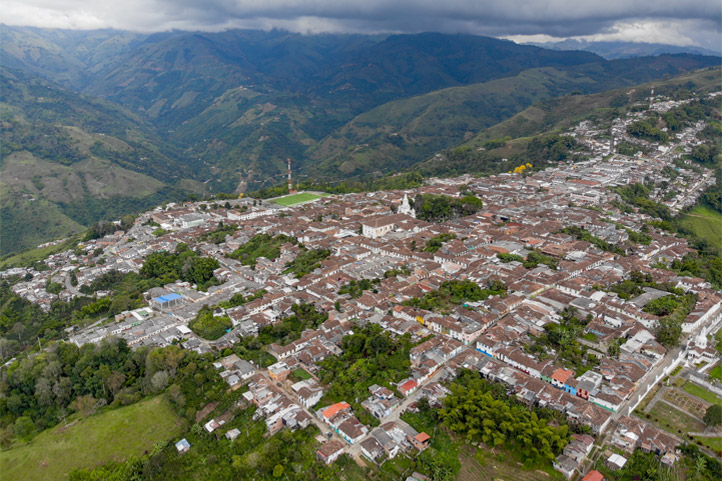
History
The historical narrative of Salamina is marked by key events that have shaped its identity:
- 1825: Salamina was founded on January 5, 1825, by Fermin Lopez. This period was a time of significant transformation in Colombia, following its independence from Spanish rule. The founding of Salamina reflects the nation’s expansion and development during this era.
- 19th Century: In the years following its foundation, Salamina played an important role in the region’s agricultural development. The town’s economy was largely based on coffee production, which became a cornerstone of its growth.
- Early to Mid-20th Century: During this period, Salamina experienced cultural and economic growth. The town became known for its traditional architecture and began to develop a distinct cultural identity, influenced by the Antioquian colonization.
- 1982: In recognition of its well-preserved traditional architecture and historical importance, Salamina was designated a National Monument. This honor was crucial in preserving its unique architectural style, known as the “Antioquian Architecture,” which includes brightly colored houses, intricately carved woodwork, and large balconies.
- Late 20th Century: Salamina became increasingly known for its cultural heritage, particularly in terms of architecture and traditional Colombian customs. Efforts were made to preserve the town’s historical buildings and promote cultural tourism.
- 21st Century: In recent years, Salamina has become a popular destination for tourists seeking to experience Colombia’s cultural heritage and natural beauty. The town’s coffee production continues to play a significant role in its economy.
- Recent Developments: Today, Salamina is not only a testament to Colombia’s historical and architectural legacy but also a center for coffee culture. It continues to attract visitors with its charming streets, traditional houses, and the surrounding coffee landscapes.
The evolution of Salamina from a 19th-century foundation to a national monument underscores its significance in Colombia’s cultural and historical tapestry, particularly highlighting its contribution to the nation’s architectural and agricultural heritage.
Economy
The economy of Salamina thrives on coffee production, tourism, and artisanal crafts. The town’s colonial architecture and cultural events attract visitors, contributing to its economic vitality.
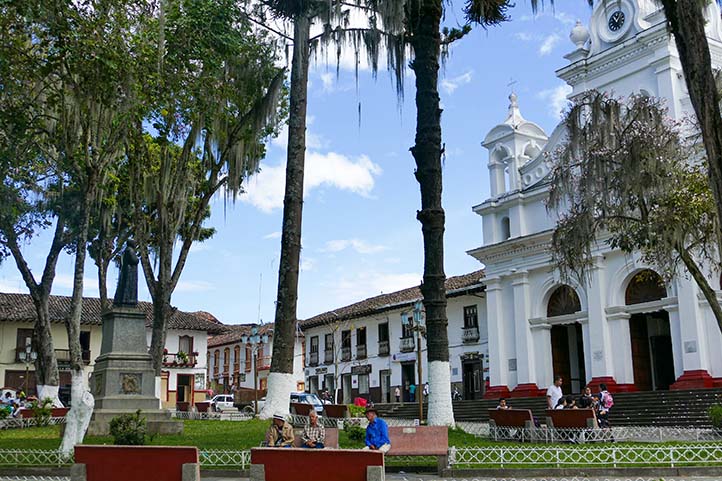
Tourism
Salamina has become a sought-after destination for those seeking a peaceful retreat and a glimpse into Colombia’s coffee culture.
Tourist Attractions and Activities
- Plaza Bolívar: Explore the main square surrounded by colorful colonial buildings.
- Casa de la Cultura: Visit this cultural center for exhibitions and events.
- Mirador El Alto de la Cruz: Enjoy panoramic views of the town and surrounding mountains.
- Coffee Haciendas: Discover the traditional coffee farms in the picturesque countryside.
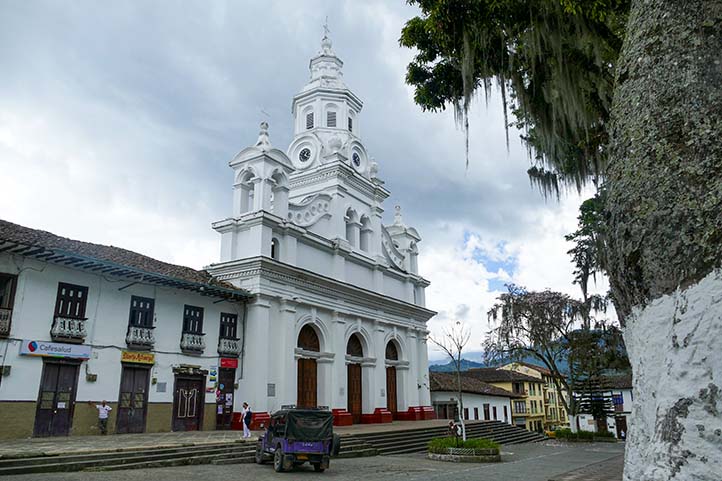
Local Food
Salamina’s culinary scene embraces traditional Colombian flavors. Visitors can savor local specialties such as “arepas” and “tamal,” reflecting the region’s culinary heritage.
Special Information
Exploring Salamina offers a journey through narrow streets adorned with brightly painted houses. The town hosts the Festival of Lights, adding vibrancy to its historical ambiance.
How to get to Salamina
Salamina is approximately 40 kilometers (25 miles) from Manizales, accessible by car or public transportation. The scenic journey provides an opportunity to experience the beauty of the Caldas mountains.
Aguadas
Location: Caldas Department, Colombia
Population: Approximately 12,000 residents
Weather and Climate: Aguadas boasts a mild climate with average temperatures around 22°C (72°F). The dry season typically spans from December to February.
Elevation: 1,890 meters (6,201 feet) above sea level
Foundation Date: Founded on August 15, 1812, by José María Gómez.
Local Culture
Aguadas, situated in the heart of Caldas, reflects a vibrant local culture. Designated a Historical and Cultural Heritage of Colombia, the town preserves its heritage through traditional practices and colonial architecture.
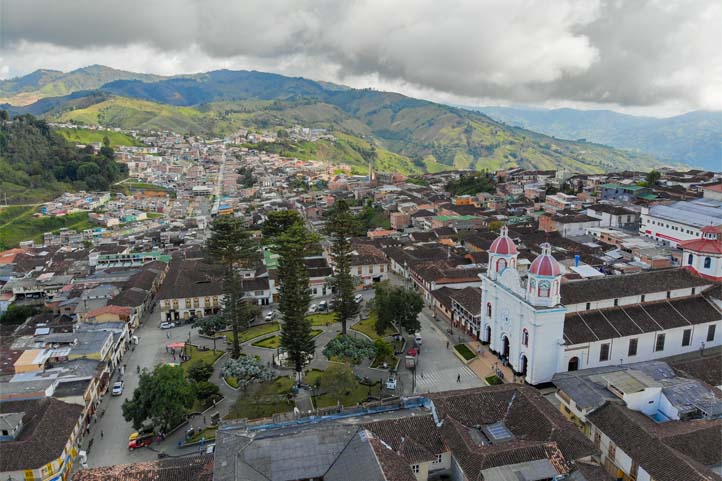
History
Aguadas, a town with a rich historical tapestry, has undergone several significant developments:
- 1812: Aguadas was founded on August 15, 1812, by José María Gómez. This foundation in the early 19th century placed Aguadas in the context of a period marked by Colombia’s struggles for independence and the reshaping of its national identity.
- 19th Century: Following its establishment, Aguadas became an important center for agricultural and economic development in the region. The town’s growth was significantly driven by coffee cultivation, which soon became the mainstay of its economy.
- Early 20th Century: During this time, Aguadas continued to grow as a coffee-producing area. The town’s architecture, culture, and social structures were heavily influenced by the Antioquian colonization, which brought new techniques in coffee cultivation and a distinct architectural style.
- Mid 20th Century: The town began to gain recognition for its cultural significance, particularly in terms of its traditional music, dances, and crafts, including the famous “sombrero Aguadeño” (Aguadas hat).
- 1992: Acknowledging its rich architectural and historical heritage, Aguadas was declared Historical and Cultural Heritage of Colombia in 1992. This designation was a major milestone in recognizing and preserving the town’s colonial and Antioquian architecture, as well as its cultural traditions.
- Late 20th and Early 21st Century: Aguadas became a point of interest for cultural tourism. The town started to attract visitors not just for its coffee culture but also for its historical significance, traditional festivals, and crafts.
- Recent Developments: Today, Aguadas continues to balance the preservation of its historical and cultural heritage with modern development. The town is celebrated for its contributions to Colombian culture, particularly in coffee production, traditional crafts, and its preserved Antioquian architecture.
The history of Aguadas, from its 19th-century foundation to its recognition as a site of historical and cultural heritage, showcases its evolution as an integral part of Colombia’s cultural and economic fabric.
Economy
The economy of Aguadas thrives on agriculture, particularly coffee cultivation, and traditional crafts. The town’s colonial charm and local festivals attract visitors, contributing to its economic sustenance.
Tourism
Aguadas has become a hidden gem for those seeking a tranquil escape and a taste of Colombia’s rural life.
Tourist Attractions and Activities
- Parque Principal: Explore the main park surrounded by colonial-style buildings.
- Casa de la Cultura: Visit this cultural center showcasing local art and traditions.
- Mirador La Cumbre: Enjoy panoramic views of the town and surrounding landscapes.
- Coffee Farms: Experience the coffee-making process in the scenic countryside.
Local Food
Aguadas’ culinary offerings reflect traditional Colombian flavors. Visitors can indulge in local delights such as “almojábanas” and “mazamorra.”
Special Information
A visit to Aguadas provides a serene experience, with its cobblestone streets and welcoming community. The town hosts the Festival of the Coffee Culture, adding vibrancy to its historical ambiance.
How to get to Aguadas
Aguadas is approximately 50 kilometers (31 miles) from Manizales, accessible by car or public transportation. The journey offers glimpses of the picturesque countryside and the rural beauty of Caldas.
Jardín
Location: Antioquia Department, Colombia
Population: Approximately 13,000 residents
Weather and Climate: Jardín enjoys a mild climate with average temperatures around 24°C (75°F). The dry season typically spans from December to February.
Elevation: 1,525 meters (5,003 feet) above sea level
Foundation Date: Founded on September 11, 1863, by Juan de Dios Aranzazu.
Local Culture
Jardín, nestled in the picturesque Antioquian mountains, is a cultural haven. Recognized for its architectural and cultural significance, the town embodies the charm of Colombia’s heritage.
History
Jardín, known for its picturesque landscapes and rich cultural heritage, has a history marked by several key milestones:
- 1863: The founding of Jardín took place on September 11, 1863, by Juan de Dios Aranzazu. This establishment in the mid-19th century coincided with a period of national growth and development following Colombia’s independence.
- Late 19th Century: After its foundation, Jardín began to develop as a center for coffee production, which became a major driver of its economy. The town’s architecture started to take shape, with colorful houses and colonial-style buildings becoming characteristic features.
- Early 20th Century: During this period, Jardín continued to grow as a coffee-producing town, with its economy and culture heavily influenced by the industry. The town’s unique blend of natural beauty and architecture began to attract attention.
- Mid 20th Century: Jardín’s cultural significance started to become more pronounced. The town was recognized for its traditional customs, festivals, and unique architectural style, which includes brightly colored facades and intricately carved woodwork.
- 1985: Recognizing its historical and architectural significance, Jardín was declared a National Monument in 1985. This designation helped to preserve its unique architectural heritage and underscored its importance as a part of Colombia’s cultural and historical identity.
- Late 20th and Early 21st Century: Following its declaration as a National Monument, Jardín began to attract more tourists. The town’s blend of natural beauty, historical architecture, and coffee culture made it a popular destination.
- Recent Years: Today, Jardín continues to thrive as both a coffee-producing town and a tourist destination. Efforts have been made to maintain its cultural and architectural heritage while embracing modern development.
- Ongoing Preservation and Tourism: Jardín actively works to preserve its cultural traditions and historical architecture. The town’s commitment to maintaining its unique identity continues to attract visitors looking to experience its charming streets, vibrant culture, and stunning natural surroundings.
Jardín’s journey from its mid-19th-century foundation to its status as a National Monument reflects its importance in Colombia’s cultural and historical landscape, particularly highlighting its contribution to the country’s architectural diversity and coffee production heritage.
Economy
The economy of Jardín thrives on coffee cultivation, tourism, and craftsmanship. The town’s well-preserved colonial architecture and vibrant local events contribute to its economic prosperity.
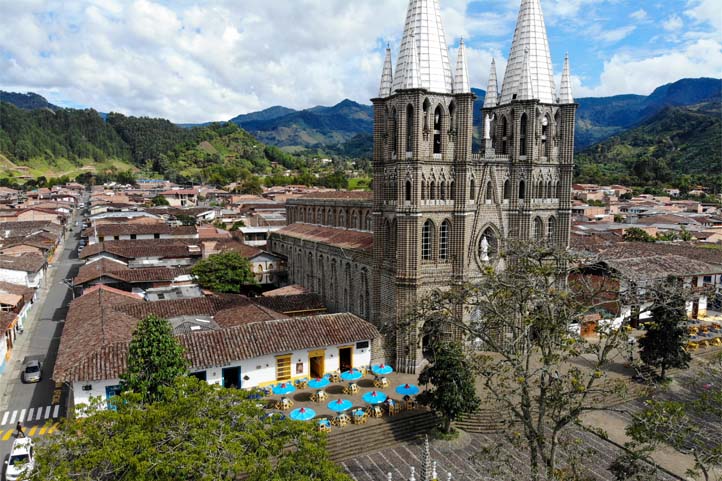
Tourism
Jardín has become a sought-after destination for those seeking a blend of natural beauty and historical richness.
Tourist Attractions and Activities
- Parque Principal: Explore the main square surrounded by colorful colonial buildings.
- Basilica Menor de la Inmaculada Concepción: Visit this iconic church with stunning architecture.
- Teleférico La Garrucha: Enjoy panoramic views of the town and surrounding landscapes.
- Cueva del Esplendor: Discover the impressive cave and waterfall in the nearby mountains.
Local Food
Jardín’s culinary scene reflects traditional Antioquian flavors. Visitors can savor local specialties such as “bandeja paisa” and “arequipe.”
Special Information
Exploring Jardín offers a journey through cobblestone streets, lush landscapes, and a warm community. The town hosts the Festival de las Flores, adding vibrancy to its historical ambiance.
How to get to Jardín
Jardín is approximately 130 kilometers (81 miles) from Medellín, accessible by car or public transportation. The scenic journey takes you through the breathtaking landscapes of the Andean region.
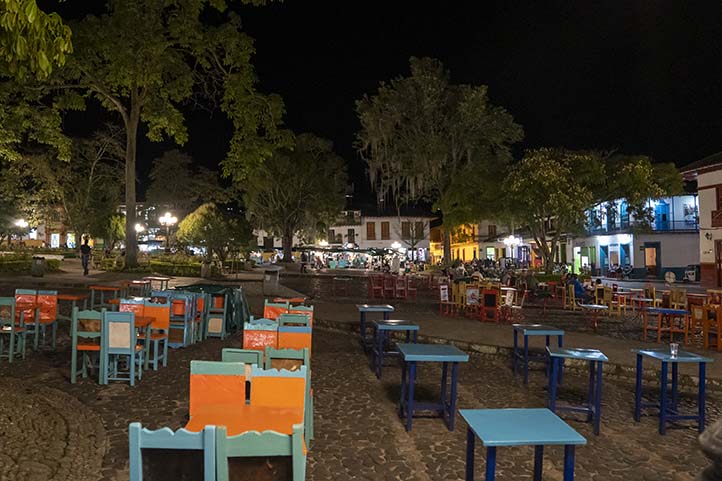
Jericó
Location: Antioquia Department, Colombia
Population: Approximately 12,000 residents
Weather and Climate: Jericó enjoys a moderate climate with average temperatures around 22°C (72°F). The dry season typically spans from December to February.
Elevation: 1,940 meters (6,365 feet) above sea level
Foundation Date: Founded on January 18, 1850, by Francisco Javier Arias Peláez.
Local Culture
Jericó, nestled in the hills of Antioquia, is a cultural gem. Recognized for its religious heritage and well-preserved architecture, the town showcases the traditions of Colombia.
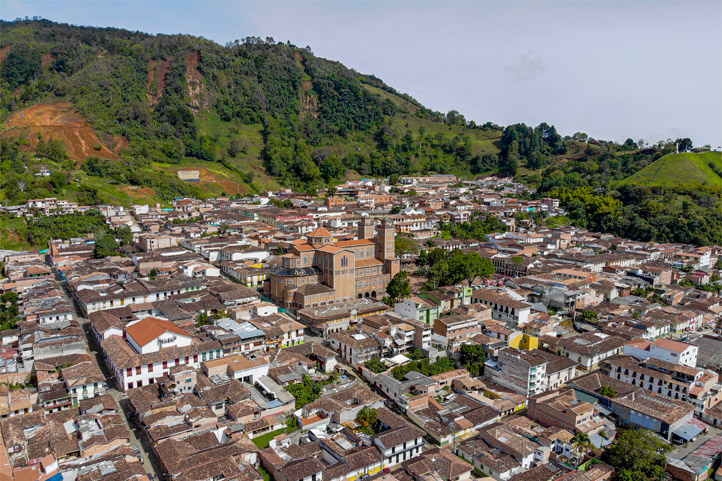
History
The historical narrative of Jericó is highlighted by significant events that have shaped its cultural and architectural identity:
- 1850: Jericó was founded on January 18, 1850, by Francisco Javier Arias Peláez. This establishment in the mid-19th century marked the beginning of the town’s development during a period of national transformation and growth in Colombia.
- 19th and Early 20th Century: In the years following its foundation, Jericó evolved into an important center for agriculture, particularly in coffee cultivation. This era saw the town develop its unique architectural style, characterized by colorful houses and ornate balconies.
- Mid 20th Century: Jericó began to gain recognition for its cultural significance and traditional crafts, particularly its religious artifacts and the production of the Carriel Jericano, a traditional leather satchel.
- 1983: Acknowledging its rich architectural and historical heritage, Jericó was declared a National Monument in 1983. This distinction was crucial in preserving its unique Antioquian architecture and in recognizing its role in Colombia’s historical narrative.
- Late 20th Century: Following this recognition, Jericó started attracting more attention as a cultural and historical destination. The town’s efforts in preserving its traditional architecture and customs began to pay off, drawing tourists and cultural enthusiasts.
- 21st Century: In recent years, Jericó has continued to balance the preservation of its historical heritage with modern development. The town is known for its vibrant culture, religious significance, and as the birthplace of Mother Laura, the first Colombian saint.
- Recent Developments: Today, Jericó is not only a testament to Colombia’s historical and architectural legacy but also a center for religious pilgrimage and cultural tourism. The town continues to attract visitors with its charming streets, traditional crafts, and stunning natural surroundings.
Jericó’s journey from its foundation in the mid-19th century to its recognition as a National Monument highlights its importance in Colombia’s cultural and historical tapestry, particularly showcasing its architectural beauty and cultural richness.
Economy
The economy of Jericó thrives on agriculture, particularly coffee production, and tourism. The town’s colonial charm, religious sites, and local festivals attract visitors, contributing to its economic vitality.
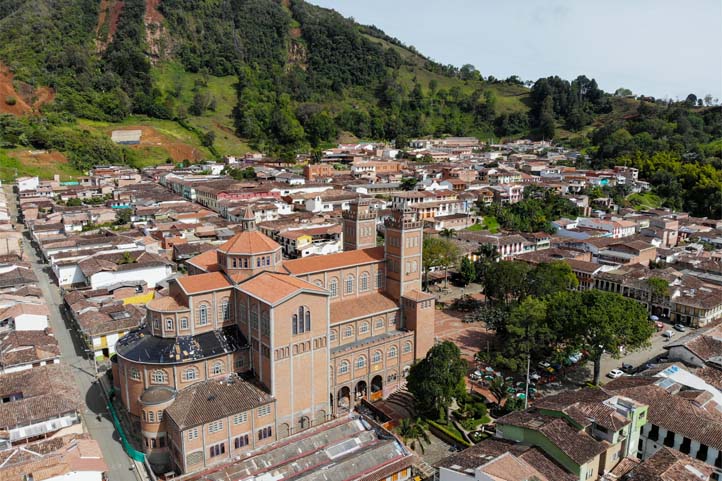
Tourism
Jericó has become a destination for those seeking tranquility, religious heritage, and a taste of Colombia’s rural life.
Tourist Attractions and Activities
- Parque Principal: Explore the main square surrounded by colonial-style buildings.
- Basílica Menor de la Inmaculada Concepción: Visit this iconic church with stunning architecture.
- Cerro las Nubes: Hike to this scenic viewpoint overlooking the town.
- Calle de la Amargura: Stroll through the historic street with colorful houses.
Local Food
Jericó’s culinary scene embraces traditional Antioquian flavors. Visitors can indulge in local delights such as “buñuelos” and “café de chorreador.”
Special Information
Exploring Jericó offers a journey through cobblestone streets, religious sites, and a close-knit community. The town hosts the Festival de las Mariposas, adding vibrancy to its historical ambiance.
How to get to Jericó
Jericó is approximately 115 kilometers (71 miles) from Medellín, accessible by car or public transportation. The scenic journey takes you through the rolling hills and picturesque landscapes of the Antioquia region.
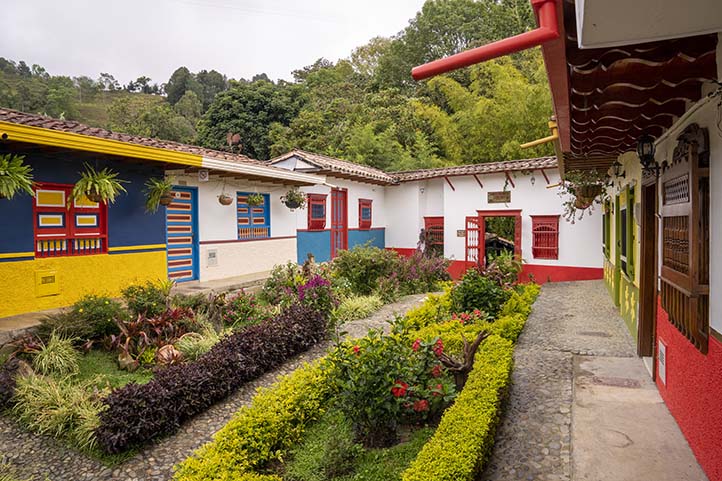
Santa Fe de Antioquia
Location: Antioquia Department, Colombia
Population: Approximately 23,000 residents
Weather and Climate: Santa Fe de Antioquia enjoys a warm climate with average temperatures around 27°C (81°F). The dry season typically spans from December to February.
Elevation: 490 meters (1,608 feet) above sea level
Foundation Date: Founded on March 7, 1541, by Jorge Robledo.
Local Culture
Santa Fe de Antioquia, a colonial jewel, is a living testament to Antioquia’s cultural richness. Recognized for its historical significance, the town preserves its heritage through well-preserved architecture and local traditions.
History
Santa Fe de Antioquia’s rich history is punctuated by key events that have shaped its identity:
- 1541: The town was founded on March 7, 1541, by Jorge Robledo. This early establishment makes it one of the oldest cities in Colombia, and it played a significant role in the country’s colonial history.
- 16th and 17th Centuries: Throughout these centuries, Santa Fe de Antioquia served as an important administrative and political center during the Spanish colonial era. Its strategic location contributed to its status as a hub for regional governance and trade.
- 18th Century: The town saw considerable growth and development. It became known for its beautiful colonial architecture, including churches, plazas, and mansions, which were built during this period.
- 19th Century: With Colombia’s independence from Spain, Santa Fe de Antioquia began to experience changes, adapting to the new republic’s needs while maintaining its historical and cultural significance.
- 1960: Recognizing its architectural beauty and historical relevance, Santa Fe de Antioquia was declared a National Monument. This designation was a testament to its well-preserved colonial architecture and its importance in Colombian history.
- Late 20th Century: The town began to focus more on tourism, capitalizing on its historical significance and well-preserved colonial architecture. It became a destination for those interested in Colombia’s colonial past.
- 21st Century: In recent years, Santa Fe de Antioquia has continued to balance historical preservation with modern development. The town has become a cultural and historical hub, attracting visitors from around the world with its charming streets and colonial heritage.
- Ongoing Efforts: The town actively works to preserve its cultural traditions and historical architecture, making it a living museum of Colombia’s colonial era.
Santa Fe de Antioquia’s journey from its foundation in the early colonial period to its recognition as a National Monument reflects its vital role in Colombia’s cultural and historical landscape, particularly highlighting its architectural and historical significance.
Economy
The economy of Santa Fe de Antioquia thrives on tourism, commerce, and agriculture. The town’s colonial charm, cobbled streets, and cultural events attract visitors, contributing to its economic vibrancy.
Tourism
Santa Fe de Antioquia has become a popular destination for those seeking a step back in time and a glimpse into Colombia’s colonial past.
Tourist Attractions and Activities
- Plaza Mayor: Explore the main square surrounded by well-preserved colonial buildings.
- Catedral Basílica Metropolitana: Visit the historic cathedral showcasing exquisite architecture.
- Ponte de Occidente: Cross the iconic bridge spanning the Cauca River.
- Museo Juan del Corral: Discover artifacts and art pieces depicting the town’s history.
Local Food
Santa Fe de Antioquia’s culinary scene reflects traditional Antioquian flavors. Visitors can savor local specialties such as “bandeja paisa” and “carne en polvo.”
Special Information
Exploring Santa Fe de Antioquia offers a journey through time, with its colonial architecture and charming ambiance. The town hosts the Festival de la Semana Santa, adding cultural richness to its historical setting.
How to get to Santa Fe de Antioquia
Santa Fe de Antioquia is approximately 55 kilometers (34 miles) from Medellín, accessible by car or public transportation. The short journey provides an opportunity to experience the transition from city life to the tranquility of the colonial town.
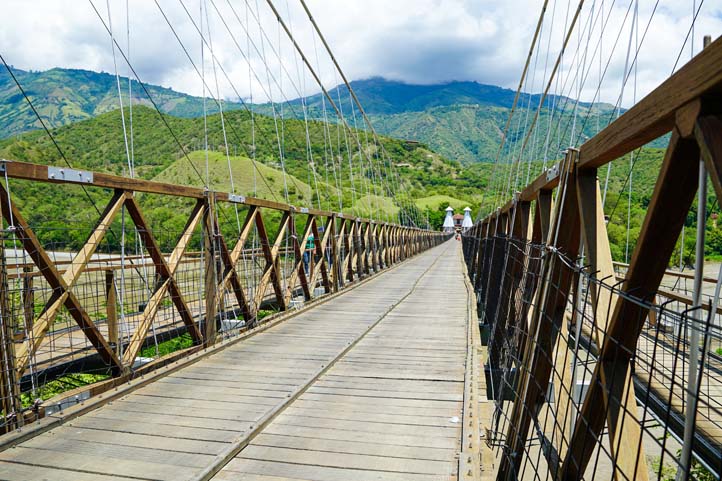
Ciénaga
Location: Magdalena Department, Colombia
Population: Approximately 100,000 residents
Weather and Climate: Ciénaga enjoys a tropical climate with average temperatures around 28°C (82°F). The dry season typically spans from December to February.
Elevation: Sea level
Foundation Date: Founded on June 22, 1525, by Rodrigo de Bastidas.
Local Culture
Ciénaga, nestled along the Caribbean coast, is a vibrant reflection of Colombia’s coastal culture. With a mix of African, Indigenous, and Spanish influences, the town boasts a rich cultural heritage expressed through its music, dance, and traditions.
History
Ciénaga’s history, rich and diverse, is marked by several significant events:
- 1525: The town of Ciénaga was founded on June 22, 1525, by Spanish explorer Rodrigo de Bastidas. This early establishment places Ciénaga among the oldest settlements in Colombia, marking the beginning of its long and varied history.
- 16th and 17th Centuries: During these centuries, Ciénaga developed as a significant port town. Its strategic location near the Caribbean Sea made it a vital point for trade and commerce during the Spanish colonial period.
- 18th and 19th Centuries: Ciénaga continued to grow as a commercial hub, with its economy largely driven by trade. The town also played a role in the political and social changes occurring in Colombia during its journey towards independence.
- Banana Plantations Era: In the late 19th and early 20th centuries, Ciénaga became central to the banana plantation economy. This era was marked by the influence of foreign companies and the influx of migrant workers, which significantly shaped the town’s social and economic landscape.
- 1928 Banana Massacre: A pivotal event in Ciénaga’s history is the Banana Massacre of 1928, a significant event in Colombian history, where many workers at United Fruit Company plantations were killed during a labor strike. This event had profound implications for labor rights and politics in Colombia.
- 1982: Acknowledging its rich architectural and historical heritage, Ciénaga was declared a National Monument in 1982. This designation was essential for recognizing and preserving the town’s colonial architecture and its role in the nation’s history.
- Late 20th and Early 21st Century: Following its declaration as a National Monument, Ciénaga began to focus on tourism and cultural preservation. The town’s historical significance and unique architecture started attracting visitors from around the world.
- Recent Years: Today, Ciénaga continues to balance its historical preservation with modern development. The town is celebrated for its contributions to Colombian culture and history, particularly in the context of its colonial past and its role in the banana plantation economy.
Ciénaga’s history, from its foundation in the early 16th century to its recognition as a National Monument, underscores its importance in Colombia’s cultural and historical tapestry, particularly highlighting its role in trade, agriculture, and as a witness to significant historical events.
Economy
The economy of Ciénaga thrives on fishing, agriculture, and commerce. The town’s coastal charm, historical sites, and cultural events attract visitors, contributing to its economic diversity.
Tourism
Ciénaga has become a destination for those seeking a coastal retreat and an exploration of Colombia’s Caribbean culture.
Tourist Attractions and Activities
- Parque Santander: Explore the main square surrounded by colonial and colorful buildings.
- Basilica de la Candelaria: Visit the historic basilica showcasing colonial architecture.
- Ciénaga Grande: Discover the largest coastal lagoon in Colombia, a haven for birdwatching.
- Pueblos Palafitos: Explore the stilted fishing villages along the coastline.
Local Food
Ciénaga’s culinary scene is a delightful mix of seafood and traditional Colombian dishes. Visitors can savor local specialties such as “arroz con coco” and “ceviche.”
Special Information
Exploring Ciénaga offers a blend of coastal landscapes, historical charm, and lively cultural experiences. The town hosts the Festival de la Candelaria, adding vibrancy to its coastal ambiance.
How to get to Ciénaga
Ciénaga is approximately 35 kilometers (22 miles) from Santa Marta, accessible by car or public transportation. The journey takes you through scenic coastal landscapes and mangrove forests.
Guadalajara de Buga
Location: Valle del Cauca Department, Colombia
Population: Approximately 120,000 residents
Weather and Climate: Guadalajara de Buga enjoys a warm climate with average temperatures around 24°C (75°F). The dry season typically spans from December to February.
Elevation: 1,060 meters (3,478 feet) above sea level
Foundation Date: Founded on July 3, 1555, by Sebastián de Belalcázar.
Local Culture
Guadalajara de Buga, often referred to as simply Buga, is a cultural hub in the Valle del Cauca region. With a mix of Indigenous, Spanish, and Afro-Colombian influences, the town celebrates its rich cultural heritage through festivals, music, and dance.
History
The historical journey of Buga is highlighted by significant events that have shaped its development:
- 1555: Buga was founded on July 3, 1555, by Spanish conquistador Sebastián de Belalcázar. This foundation during the colonial era marked the beginning of its development as an important settlement in the New World.
- 16th and 17th Centuries: During these centuries, Buga played a significant role as a colonial center in the region. The town became a hub for religious activities and agricultural development, especially in the sugarcane industry.
- 18th Century: Buga’s growth continued, with the establishment of numerous churches and religious convents, reflecting its importance as a religious center. The town also saw the development of its colonial architecture during this period.
- 19th Century: With the independence of Colombia, Buga underwent social and economic transformations. The town maintained its status as an agricultural and religious center while adapting to the changes brought about by the new republic.
- 1959: Recognizing its rich historical and architectural heritage, Buga was declared a National Monument in 1959. This designation aimed to preserve its colonial architecture and historical significance.
- Late 20th Century: Following this recognition, Buga began to focus more on tourism, highlighting its historical significance and well-preserved colonial architecture. The Basilica of the Lord of Miracles became a major religious and tourist attraction.
- 21st Century: In recent years, Buga has continued to balance the preservation of its historical heritage with modern development. The town has become a destination for religious pilgrims and tourists interested in colonial history and architecture.
- Ongoing Developments: Today, Buga actively works to maintain its cultural traditions and historical architecture, making it a significant location in Colombia’s cultural and religious landscape.
The history of Buga, from its foundation in the mid-16th century to its recognition as a National Monument, reflects its importance in Colombia’s cultural, historical, and religious narrative, particularly highlighting its colonial legacy and religious significance.
Economy
The economy of Buga thrives on commerce, agriculture, and religious tourism. The town’s colonial architecture, historical sites, and religious events attract visitors, contributing to its economic vitality.
Tourism
Buga has become a destination for those seeking a blend of history, culture, and religious experiences.
Tourist Attractions and Activities
- Basílica del Señor de los Milagros: Visit the iconic basilica, an important pilgrimage site.
- Parque José María Cabal: Explore the main park surrounded by colonial-style buildings.
- Museo Religioso y Colonial: Discover artifacts and art pieces depicting Buga’s history.
- Cerro de las Tres Cruces: Hike to this viewpoint for panoramic views of the town.
Local Food
Buga’s culinary scene reflects traditional Valle del Cauca flavors. Visitors can savor local specialties such as “sancocho de gallina” and “masato.”
Special Information
Exploring Buga offers a journey through colonial streets, religious fervor, and a warm community. The town hosts the Fiesta de San Pedro, adding vibrancy to its historical and religious ambiance.
How to get to Guadalajara de Buga
Buga is approximately 60 kilometers (37 miles) from Cali, accessible by car or public transportation. The journey takes you through the scenic landscapes of the Valle del Cauca region.
La Playa de Belén
- Location: La Playa de Belén is situated in the Norte de Santander Department of Colombia.
- Population: The town boasts a small, closely-knit community, reflective of its serene and rural character.
- Weather and Climate: Characterized by a temperate climate, La Playa de Belén enjoys mild temperatures year-round, fostering a rich biodiversity.
- Elevation: The town’s elevation contributes to its distinct climatic conditions, offering a unique environment for both flora and fauna.
- Foundation Date: Steeped in history, La Playa de Belén’s establishment dates back several centuries, marking significant cultural evolution.
Local Culture
La Playa de Belén prides itself on a rich cultural heritage that includes traditional Colombian customs, regional festivals, and a strong community spirit.
History
- Pre-Colonial Era (Before 1492): The region that would become Playa de Belén was originally inhabited by indigenous communities. These groups had their distinct cultures and social systems, forming the bedrock of the area’s early history.
- Spanish Colonization Period (1492 – Early 19th Century): With the arrival of the Spanish in Colombia, Playa de Belén witnessed significant changes. This era brought European customs, architecture, and Christianity, leading to a melding of indigenous traditions with Spanish influences.
- Post-Independence Era (Early 19th Century – Late 19th Century): After Colombia gained independence from Spain, Playa de Belén began forging its unique identity, influenced by both its indigenous roots and colonial past.
- 20th Century: During this century, the town continued to honor its rich cultural heritage while adapting to modernity. It preserved its colonial architecture and celebrated its diverse cultural legacy through various festivals and events.
- Late 20th to Early 21st Century: In recent decades, there has been a concerted effort to preserve and highlight Playa de Belén’s historical and cultural heritage. The town focused on maintaining its traditional architecture and customs, enhancing its appeal as a cultural tourism destination.
- Contemporary Period (21st Century): Today, Playa de Belén is celebrated for its unique combination of colonial and indigenous heritages. The town exemplifies Colombia’s diverse cultural history, balancing the preservation of its past with contemporary development.
Economy
Primarily agrarian, La Playa de Belén’s economy revolves around local farming and agriculture, sustaining its community and preserving traditional practices.
Tourism
Known for its ecotourism, La Playa de Belén attracts those interested in bird watching, nature exploration, and experiencing authentic Colombian village life.
Tourist Attractions and Activities in La Playa de Belén
- Natural Reserves: Rich in biodiversity, these reserves are perfect for eco-enthusiasts.
- Local Markets: A vibrant showcase of local culture and cuisine.
- Cultural Festivals: Celebrations that epitomize the town’s traditions and heritage.
Local Food
La Playa de Belén offers a taste of regional Colombian cuisine, featuring dishes made with locally sourced ingredients.
Special Information
Visitors can immerse themselves in the tranquility of rural Colombian life, surrounded by natural beauty and rich cultural experiences.
How to Get to La Playa de Belén
Accessible by road from major Colombian cities, the journey to La Playa de Belén provides scenic countryside vistas and a glimpse into Colombia’s rural landscapes.
Santa Cruz de Lorica
- Location: Santa Cruz de Lorica is located in the Córdoba Department, Northern Colombia.
- Population: The town has a sizable population, reflecting its status as an important regional center.
- Weather and Climate: Santa Cruz de Lorica experiences a tropical savanna climate, with a distinct wet and dry season, and generally warm temperatures throughout the year.
- Elevation: The town is situated at a low elevation, close to sea level, which contributes to its tropical climate.
- Foundation Date: Santa Cruz de Lorica has a rich historical background, with its foundation dating back to the colonial era.
Local Culture
Santa Cruz de Lorica is renowned for its diverse cultural heritage, influenced by various ethnic groups. The town is particularly known for its unique architectural style, blending colonial and Arabic influences, often referred to as “Republican.”
History
- Early Settlements (Pre-Colonial Era): Before the arrival of European colonizers, the area where Santa Cruz de Lorica is located was inhabited by indigenous groups. These early communities laid the foundational cultural and societal structures of the region.
- Spanish Colonization (16th – 19th Century): With the advent of Spanish colonization, Santa Cruz de Lorica began to take shape as a strategic river port. Its location along the Sinú River made it a crucial point for trade and communication, linking the interior regions of Colombia with the Caribbean coast.
- Development as a Trading Hub (19th Century): During the 19th century, Lorica’s role as a river port became even more prominent. The town developed economically and culturally due to its strategic position, facilitating the exchange of goods, ideas, and cultural practices.
- Economic and Cultural Boom (Late 19th – Early 20th Century): In this period, Lorica experienced significant growth. The town became a melting pot of cultures, with influences from indigenous groups, Spanish colonizers, and later, Middle Eastern immigrants, particularly from Lebanon and Syria.
- Mid 20th Century: Throughout the 20th century, Lorica continued to thrive as a cultural and economic center. Despite the decline in river transportation, the town maintained its economic relevance through agriculture and trade.
- Modern Developments (Late 20th – 21st Century): In recent decades, Santa Cruz de Lorica has focused on preserving its rich cultural heritage, including its unique architecture, known as the “Republican Style,” which blends colonial and Arabic influences. The town has also become a point of interest for cultural and historical tourism in Colombia.
- Contemporary Era (21st Century): Today, Santa Cruz de Lorica stands as a testament to its diverse historical influences. It continues to celebrate its rich cultural tapestry, shaped by its strategic location as a river port and the various communities that have contributed to its development over the centuries.
Economy
The economy of Santa Cruz de Lorica is diverse, encompassing agriculture, fishing, and trade. Its historical role as a trading port has been central to its economic growth.
Tourism
Santa Cruz de Lorica attracts tourists with its architectural beauty, cultural richness, and historical significance. The town’s preservation of historical buildings and its riverside setting make it a unique destination.
Tourist Attractions and Activities in Santa Cruz de Lorica
- Historical Center: Known for its unique architectural style.
- Local Markets: Offering a glimpse into the town’s vibrant culture and cuisine.
- Riverside Promenade: A picturesque spot for leisure and relaxation.
- Cultural Festivals: Showcasing the town’s rich traditions and diverse heritage.
Local Food
The cuisine in Santa Cruz de Lorica is a reflection of its cultural diversity, with a variety of local dishes that blend indigenous, Spanish, and Arabic flavors.
Special Information
Visiting Santa Cruz de Lorica offers an opportunity to experience a blend of cultures and history, set in a town known for its architectural uniqueness and cultural richness.
How to Get to Santa Cruz de Lorica
The town is accessible by road and is well-connected to major cities in Colombia. Its proximity to the Sinú River also makes it accessible by river, adding a unique aspect to the travel experience.
Santa Cruz de Mompox
- Location: Santa Cruz de Mompox is situated in the Bolívar Department of Colombia, on the banks of the Magdalena River.
- Population: The town has a modest population, reflective of its historical and cultural significance rather than its size.
- Weather and Climate: Mompox enjoys a tropical climate, characterized by hot temperatures and high humidity, with distinct wet and dry seasons.
- Elevation: Located near sea level, Mompox’s elevation contributes to its tropical weather patterns.
- Foundation Date: Founded in 1537 by Spanish conquistadors, Mompox boasts a rich history dating back to the early colonial period.
Local Culture
Santa Cruz de Mompox is renowned for its well-preserved colonial architecture and has been designated a UNESCO World Heritage Site. The town’s culture is a fusion of indigenous, African, and Spanish influences, evident in its festivals, music, and crafts.
History
- Founding and Early Development (1530 – 17th Century): Mompox was founded in 1530 by Spanish conquistadors. Its strategic location on the Magdalena River quickly established it as a vital trading hub during the Spanish colonial period. The town played an important role in the economic and cultural development of the region.
- Flourishing Trade and Cultural Exchange (17th – 18th Century): Throughout the 17th and 18th centuries, Mompox prospered as a center of commerce and cultural exchange. The town became a crucial link for transporting goods along the Magdalena River, connecting the interior of Colombia with the Caribbean Sea.
- Role in the Independence Movement (19th Century): During the early 19th century, Mompox was a significant player in Colombia’s fight for independence from Spanish rule. In 1810, the town declared its support for the independence movement, becoming one of the first towns in Colombia to do so. This period marked Mompox as a key site in the nation’s struggle for freedom.
- Economic Transition (Late 19th – Early 20th Century): As the 19th century progressed, Mompox experienced a shift in its economic structure. With changes in trade routes and transportation methods, the town’s prominence as a river port began to wane.
- Cultural Preservation and Tourism (Mid 20th Century – Present): In recent decades, Mompox has focused on preserving its rich historical and architectural heritage. The town’s well-preserved colonial architecture and its role in Colombian history have made it a UNESCO World Heritage site and a popular destination for cultural tourism.
- Modern Era (21st Century): Today, Mompox continues to celebrate its historical significance and cultural heritage. The town’s strategic location on the Magdalena River and its role in Colombia’s history remain integral to its identity and attract visitors from around the world.
Mompox’s history, from its founding as a colonial trading hub to its pivotal role in Colombia’s independence and its current status as a historical and cultural landmark, highlights its lasting importance in the nation’s historical narrative.
Economy
The economy of Mompox is largely based on tourism, handicrafts (especially filigree jewelry), and agriculture. The town’s cultural heritage is a significant driver of its economic activities.
Tourism
Santa Cruz de Mompox attracts tourists with its rich history, architectural beauty, and traditional festivals. It offers a unique glimpse into Colombia’s colonial past.
Tourist Attractions and Activities in Santa Cruz de Mompox
- Historical Architecture: Explore centuries-old churches and colonial buildings.
- Filigree Jewelry Workshops: Witness the art of traditional jewelry making.
- Festivals: Participate in local festivals that celebrate the town’s heritage.
- River Tours: Enjoy boat tours on the Magdalena River.
Local Food
The local cuisine in Mompox reflects a blend of regional Colombian flavors and traditional recipes, offering a unique culinary experience.
Special Information
Visiting Santa Cruz de Mompox is like stepping back in time, with its streets and buildings exuding the charm of the colonial era. The town is an embodiment of Colombia’s historical and cultural richness.
How to Get to Santa Cruz de Mompox
Santa Cruz de Mompox is accessible via road and river, providing a scenic journey through Colombia’s landscapes. The travel experience is enriched by the town’s remote location and historical significance.
Colombia Travel Tips
- Colombia Travel Medical Advice & Vaccination Details
- 29 Travel Tips You Need To Know Before Coming To Colombia
- 99 Facts & Information About Colombia You Should Know
- Colombia Weather Guide for Travelers
More Destinations in Colombia
- 99 Must-See Destinations that Will Make You Fall in Love with Colombia
- Colombia’s Top 23 Largest and most Important Cities – Key Data and Insights
- 7 Wonders of Colombia Complete Guide
- Colombia’s Top 117 Museums: A Cultural Traveler’s Comprehensive Journey
- 21 Spectacular Churches in Colombia
- What Are The Best Luxury Destinations In Colombia?
- Sample Luxury Travel Itinerary in Colombia
- Instagram Colombia – The 17 Most Beautiful Places for Photos
Other destinations and experiences in Colombia
- 9 Offers for Spiritual Retreats and Yoga in Colombia
- Top 15 Best Romantic Destinations in Colombia for Couples and Honeymoons
- The 11 Best Destinations for Getting Married in Colombia
- The 9 Best and Most Fun Theme Parks in Colombia
- 7 Amazing Tourism Experiences Offered by Former FARC Fighters in Colombia
- Pablo Escobar-related tourism, blessing or curse for Colombia?
- The 9 UNESCO World Heritage Sites in Colombia
- 32 Places to Discover Colombia’s Colonial Architecture
- Wine Tours and Tastings in Colombia – Explore 9 Must-Visit Vineyards
- Colombia’s 22 Most Luxurious Restaurants: Discover Them All
- Where to Find Vegetarian and Vegan Food in Colombia’s Main Cities
- Santuario Las Lajas – The Most Spectacular Basilica in Colombia
- The most important information about Filandia Quindio, Colombia
